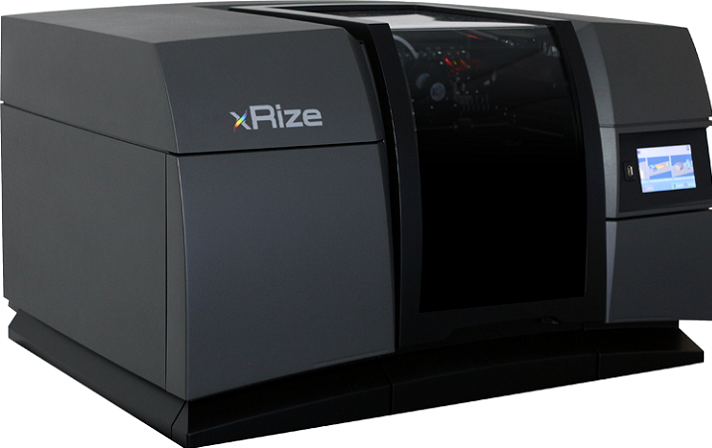Massachusetts-based 3D printing company RIZE has always taken great pride in its commitment to safety, as well it should. According to research by UL Chemical Safety, there could be more than 200 kinds of harmful compounds and invisible toxins known as ultrafine particles (UFPs) that can be exposed to and negatively affect 3D printer users, with filaments thought to be the biggest offender in releasing these emissions. RIZE President and CEO Andy Kalambi has told me in the past that the company’s 3D printers are “purpose built” for safety, and its zero-emission polymer 3D printing technology earned RIZE the Frost & Sullivan award for Best Practices in Technology Innovation, along with the New Equipment Digest Innovation Award, in 2019.
 Now, RIZE has obtained another feather in its cap—the company’s industrial, full-color XRIZE printer, along with its RIZIUM ST 3D composite filament and RIZIUM inks, have achieved prestigious UL GREENGUARD certification. While the RIZE One received its own GREENGUARD certification last year, the XRIZE is now the first color, composite 3D printer to be certified for low emissions and safe usage by UL in any market, and the RIZIUM composite and inks are the first GREENGUARD-certified materials.
Now, RIZE has obtained another feather in its cap—the company’s industrial, full-color XRIZE printer, along with its RIZIUM ST 3D composite filament and RIZIUM inks, have achieved prestigious UL GREENGUARD certification. While the RIZE One received its own GREENGUARD certification last year, the XRIZE is now the first color, composite 3D printer to be certified for low emissions and safe usage by UL in any market, and the RIZIUM composite and inks are the first GREENGUARD-certified materials.
“GREENGUARD Certification is the gold standard for 3D printing health and safety, and we’re delighted that RIZE’s materials-first approach to 3D printing is getting recognized by scientific leaders as well as major manufacturers. Our RIZIUM Alliance and continued commitment to materials innovation is enabling manufacturers, product designers and any 3D printing user to create adaptive workflows that drive safer, sustainable 3D printing and propel the next generation of advanced manufacturing,” Kalambi said in a press release.
This coveted certification, just one more milestone achieved by the RIZIUIM Alliance, is based on ANSI/CAN/UL 2904, “Standard Method for Testing and Assessing Particle and Chemical Emissions from 3D Printers,” which was created in order to help manufacturers show that 3D printers can be used safely indoors without reducing the air quality. Chemical Insights, a Research Institute of Underwriters Laboratories, together with the Georgia Institute of Technology, published a research study which explains that desktop 3D printers release unhealthy UFPs and volatile organic compounds (VOCs) into the air while they’re printing. According to the study, these emissions are lowering the indoor air quality around 3D printers in offices, hospitals, schools, and factories, which in turn compromises the health of the employees, patients, and students.
“The Standard describes in detail processes for measuring total particle concentrations over a wide range of particle sizes (ultrafine, fine and coarse) during printing using a combination of particle size and concentration analyzers,” the technical brief for the ANSI/CAN/UL 2904 standard states. “The particle emission rates (emission per hour) and yields (emission per mass of feedstock used) are calculated from measured particle concentrations with adjustments made to account for particle loss.”
The RIZIUM portfolio of 3D printing filaments and inks have very low moisture absorption, and are based on unique cyclic olefin-based materials. They don’t decompose at high temperatures, are recyclable, and were engineered with the user’s health in mind.
“GREENGUARD Certification is rigorous for a reason – because indoor 3D printing use has long been an industry issue,” explained Alberto Uggetti, vice president and general manager for UL’s environment and sustainability division. “As the first 3D printer, material and ink to earn GREENGUARD Certification, RIZE demonstrates its leadership and commitment to providing healthier indoor environments. We congratulate them on yet another sustainability and safety accomplishment.”
RIZE actively pursued this important GREENGUARD Certification, which further demonstrates its commitment to safe 3D printing materials and processes. By obtaining the certification, the company shows that its devices and materials emit lower levels of airborne, toxic chemical emissions during use, which allows them to help contribute to safer air indoors. Combine this high focus on safety with the security of the company’s Digitally Augmented Parts, and you’ve got a combination that can’t be beat.
(Source/Images: RIZE)
Subscribe to Our Email Newsletter
Stay up-to-date on all the latest news from the 3D printing industry and receive information and offers from third party vendors.
You May Also Like
Further Understanding of 3D Printing Design at ADDITIV Design World
ADDITIV is back once again! This time, the virtual platform for additive manufacturing will be holding the first-ever edition of ADDITIV Design World on May 23rd from 9:00 AM –...
3D Printer Maker EVO-tech Reborn as NEVO3D — Once More With Feeling
EVO-tech was a 3D printing service and original equipment manufacturer established in 2013 and based in Schörfling am Attersee, Austria. The company produced high-quality material extrusion systems featuring linear bearings,...
3D Systems Brings 3D Printed PEEK Cranial Implant to the U.S. with FDA Clearance
For more than 10 years, 3D Systems (NYSE:DDD) has worked hand-in-hand with surgeons to plan over 150,000 patient-specific cases, and develop more than two million instruments and implants from its...
CDFAM Returns to Berlin for Second Annual Symposium
The second CDFAM Computational Design Symposium is scheduled for May 7-8, 2024, in Berlin, and will convene leading experts in computational design across all scales. Building upon the first event...


































